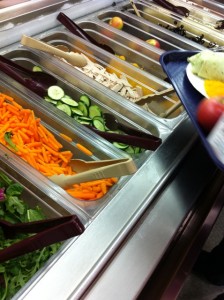Authored by: Heidi Kessler, Let’s Go! Senior Program Manager and School Nutrition Specialist
Many students will be donning new lunchboxes alongside their spiffy backpacks and pencil cases as they head off to school this September. We know, planning, prepping and making lunch to fill those boxes can be time consuming so we’re offering you an alternative – school lunch. There is a quiet revolution going on in school cafeterias throughout Maine and encouraging kids to eat school lunch can end up saving you precious time and money. 
You don’t have to throw nutrition out the window when you support your child eating school lunch. Schools have made significant improvements to their menus in the past few years. For example, Forest Hills Consolidated School in Jackman is revamping the favorite homemade peanut butter and jelly muffin to be low fat and whole grain. The tomatoes and apples offered in MSAD 59 are almost always provided by local farmers. Students at Biddeford Middle School are eating up the dinosaur kale and Southwestern Lentils are going over well in Kennebunk Elementary school. Teriyaki chicken salad is a hit at Wells Ogunquit CSD and the green beans with slivered almonds are running out at Morse Elementary School in Freeport.
 Over 250 schools across Maine, including the ones mentioned above, are leading the nation on improving school meals by joining forces with Let’s Go!, a nationally recognized childhood obesity prevention program based at The Barbara Bush Children’s Hospital at Maine Medical Center. Let’s Go! is changing the landscape of school meals in Maine by developing regional infrastructure and capacity to improve school meals. School nutrition programs are working together across district lines to identify best practices and to bring them into your child’s cafeteria. So far, over 75 of the schools working with Let’s Go! have achieved national recognition from the USDA for offering school meals that exceed the federal nutrition requirements. Only 3% of schools nationwide have received this recognition.
Over 250 schools across Maine, including the ones mentioned above, are leading the nation on improving school meals by joining forces with Let’s Go!, a nationally recognized childhood obesity prevention program based at The Barbara Bush Children’s Hospital at Maine Medical Center. Let’s Go! is changing the landscape of school meals in Maine by developing regional infrastructure and capacity to improve school meals. School nutrition programs are working together across district lines to identify best practices and to bring them into your child’s cafeteria. So far, over 75 of the schools working with Let’s Go! have achieved national recognition from the USDA for offering school meals that exceed the federal nutrition requirements. Only 3% of schools nationwide have received this recognition.
Give school lunch a second look. You may be surprised by what you find; salad bars, fresh fruit, whole grains, lean proteins and sugary drinks replaced by coolers of water.
